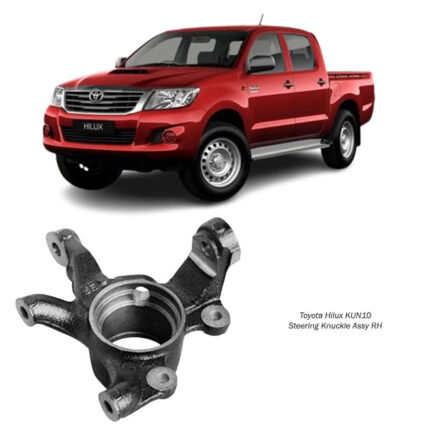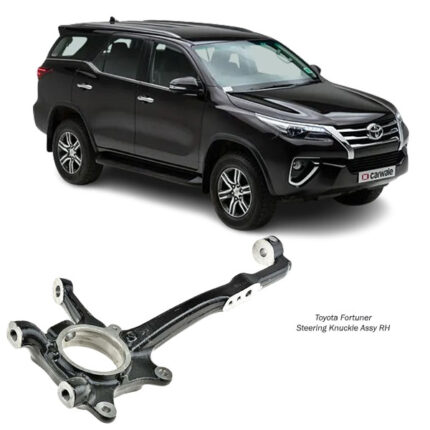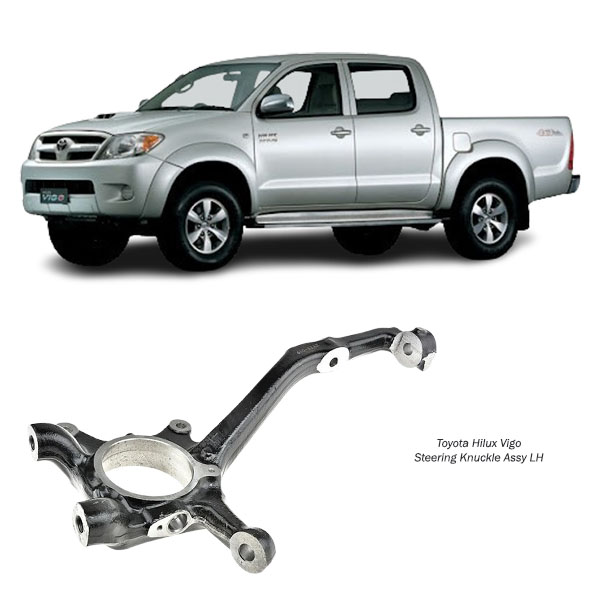-8%
Get Toyota Hilux Vigo 4WD Steering Knuckle Assy LH 43212-0k030 in Kenya
Hidden behind the wheel, often overlooked, but working non-stop — the Steering Knuckle Assembly LH (Left Hand) is a critical component of your vehicle’s front-end system. It’s strong, precisely engineered, and acts as a bridge between the wheel, suspension, steering, and braking systems. Without it, turning corners, driving straight, or even staying stable on the road wouldn’t be possible. 🛣️⚙️
Let’s take a deep dive into the structure, purpose, and importance of the LH steering knuckle assembly — the unsung hero of your vehicle’s motion.
🔍 What Is the Steering Knuckle Assembly LH?
The steering knuckle is a robust, heavy-duty component found in the front suspension system. The “LH” indicates that it is designed for the left-hand side of the vehicle — typically the driver’s side in left-hand drive vehicles.
Its primary role is to connect several key components of the front suspension and steering system, including:
-
The wheel hub and bearing
-
The brake caliper and rotor
-
The tie rod (which links the steering gear)
-
The upper and lower control arms, or strut assembly
The knuckle is the central junction where motion from the steering wheel meets the suspension and translates into movement of the wheel. Without it, none of the systems would function as intended. 🔄🛠️
⚙️ Key Functions of the Steering Knuckle
Let’s look at the critical roles the LH steering knuckle plays in your vehicle’s operation:
🛞 1. Supports the Wheel and Allows Rotation
The knuckle houses the wheel bearing and hub, which support the wheel and allow it to spin freely. The wheel is bolted onto the hub, and the hub is mounted to the knuckle.
🧭 2. Enables Steering
Connected to the tie rod, the knuckle pivots left or right when the steering wheel is turned. This movement angles the wheel in the direction you want to go.
🛑 3. Mounts Brake Components
The brake caliper is bolted to the knuckle. When you hit the brakes, the caliper squeezes the rotor (which spins with the hub), slowing down the vehicle. The knuckle must hold the caliper firmly in place under intense force.
🧱 4. Connects Suspension Components
The knuckle links to either a strut or an upper control arm and a lower control arm, forming the vertical structure that absorbs road bumps. This allows the wheel to move up and down independently of the chassis.
⚖️ 5. Transfers Load
It helps distribute the vehicle’s weight and road forces through the suspension into the wheels. The knuckle must be rigid enough to withstand this stress without flexing.
🧩 What’s Included in a Knuckle Assembly?
A knuckle assembly isn’t just a bare casting. It often comes equipped with essential components, making installation easier and more precise. A typical LH steering knuckle assembly may include:
-
Wheel hub
-
Wheel bearing
-
Dust shield or backing plate
-
Mounting points for brake calipers
-
Connection points for tie rods and ball joints
-
ABS sensor mounts 🧲
These components work together in unison, allowing the suspension, braking, and steering systems to operate with exact alignment and timing.
🏗️ Materials and Construction
Steering knuckles are typically made from materials like:
-
Forged steel – known for superior strength
-
Cast iron – durable and cost-effective
-
Aluminum alloy – lighter for performance-oriented systems
The construction must be precise and extremely durable, as the knuckle is subject to high stress from braking, cornering, and road impacts. Any deformation can affect alignment, steering geometry, and overall driving safety. 📐🔨
🧠 Why It’s So Important
Though it may not get much attention, the LH steering knuckle plays a foundational role in your vehicle’s operation:
-
It ensures the wheel rotates properly 🛞
-
It maintains steering accuracy 🧭
-
It supports braking force 🛑
-
It keeps suspension geometry in check 🔧
-
It holds all connected components in their exact places 📍
Every motion you make behind the wheel — a swerve, a U-turn, or a stop at the traffic light — is supported by this critical component.
⚠️ Signs of a Damaged Steering Knuckle
Even though steering knuckles are built tough, they’re not indestructible. Damage often comes from accidents, curb impacts, off-road driving, or corrosion over time. Here are some warning signs:
🚘 Steering Feels Loose or Off-Center
A damaged or bent knuckle can throw off steering geometry, making it harder to control your vehicle.
🌀 Vehicle Pulls to One Side
This could be a sign of uneven suspension alignment caused by a bent knuckle.
🔊 Clunking or Knocking Sounds
If you hear strange noises during turns or over bumps, the knuckle or one of its connected components may be worn or damaged.
👟 Uneven Tire Wear
If the wheel alignment is off due to a warped knuckle, your tires may wear out more quickly on one side.
🚨 ABS or Traction Control Light
If the ABS sensor mount is compromised or misaligned, it can send false signals to the vehicle’s computer.
If any of these signs are present, it’s important to have your suspension and steering systems checked promptly. The knuckle may need to be repaired or replaced to restore proper vehicle handling and safety. 🛑🔍
🧼 Maintenance and Replacement Tips
While steering knuckles don’t require regular maintenance, you can help them last longer by:
-
Avoiding harsh potholes and curbs 🚧
-
Washing off road salt and debris to prevent corrosion 🧽
-
Having suspension components inspected during tire rotations or brake services 🧰
-
Ensuring torque specs are followed during installation 🔩
When replacing a steering knuckle, always perform a wheel alignment afterward to restore proper suspension geometry. 🧭📏
💬 Final Thoughts
The Steering Knuckle Assembly LH may not be visible, but its importance is undeniable. It’s the linchpin of the front suspension and steering system — connecting, supporting, and aligning multiple parts so your car can handle the road with precision and safety. 🌟
From supporting your wheel and brakes to linking the suspension with the steering rack, this single component quietly carries a tremendous load. It’s a perfect example of how something small and hidden can play a big role in your driving experience. 💯🔧
Next time you enjoy a smooth turn or a clean stop at the light, give a silent nod of appreciation to your LH steering knuckle. It’s been working hard under there, keeping everything together — one turn at a time. 🙌🛞
Follow us on Facebook for more parts.




Reviews
Clear filtersThere are no reviews yet.